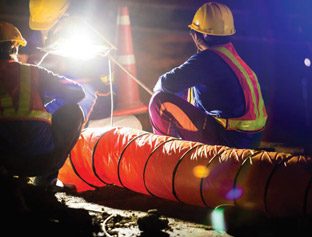
Brought to you by
For many in the tunnelling industry on-the-job training is quite literal. There are limited opportunities for a person to visit a tunnel job site prior to that first shift on that first day of work.
Liuna Local 183 in Ontario and the Greater Toronto Area is breaking ground on a new training centre this winter that will allow on-site, real tunnel training at its Vaughan campus. There will be opportunities for emergency services to experience different tunnel situations such as smoke, water and other health and safety training scenarios.
“There’s really nothing like it in Canada that’s going into this detail and just focusing on tunnel skills and safety training,” says Sandro Pinto, executive director of the Liuna Local 183 Training Centre.
The Labourers’ International Union of North America (Liuna) operates in both Canada and the US, uniting construction, waste management, show service and healthcare workers. Liuna Local 183 is the largest construction union in North America, with some 60,000 members. It has five campuses across southern Ontario and among other union benefits offers apprenticeship training, construction skills training and health and safety. In 2019 Local 183 had more than 50,000 registrations for their training programs.
On the ground

US Tariffs are shifting - will you react or anticipate?
Don’t let policy changes catch you off guard. Stay proactive with real-time data and expert analysis.
By GlobalDataThis multi-million dollar tunnelling investment is solely funded by Liuna and includes an 8,000sqft (750m2) building with classroom and garage space, but more importantly, a 10m-diameter shaft, about 25ft (7.6m) deep, connecting to a tunnel approximately 3m up to 100ft (30.5m) in diameter.
“The thought-process behind it was, there’s tunnel construction work going on for years and all the training we do at our training facilities is meant to be as real as possible,” Pinto says. He adds there’s nothing available to give people real on-site training except for the actual job sites.
“We wanted to simulate that the best we could on one of our campuses.”
Examples of training activities include laying track, working with locomotives and setting up lighting—any work that would be done down in a tunnel.
They will build the training centre by open-cut construction and place a large pipe.
“That will simulate the actual tunnel,” Pinto says. “Then inside the pipe, that’s where we’ll simulate running the track, bringing locos down, and we’ll have a large crane in the building at the top of the shaft.”
The pipe is essentially a blank canvas. Members can practice installing segments, which will later be removed. “Build it and take it down,” he says. They are also looking into adding a TBM simulator, but that would likely be in a second phase.
Health and safety
On the morning of December 2, 2019, nearly 200 commuters were evacuated from their Toronto train when the tunnel lost power. This was due to a fire, which started when a wooden board contacted the third rail, a TTC spokesperson told local media. Passengers posted their smoky, dark walk through the tunnel on social media.
Another major reason for building the tunnel training centre is that Liuna Local 183’s tunnel rescue training will be able to simulate real conditions for fire departments. The team currently goes out into the community for this. Some of their partners include City of Vaughan, Mississauga, Brampton and Toronto.
The tunnel will allow fire departments to experience different scenarios like fire, smoke and water, while trying different tactics. “We’ll have ladder access and stair access, to simulate different rescue situations,” Pinto explains.
Much like skills training for the construction, the rescue teams have limited access to actual tunnels to test their procedures. “We are going to be doing all that in an environment that we would never be able to have on site.”
He adds, “it will evolve, I’m sure, as the industry becomes more involved with it, as the fire departments become more involved with it. We have interest right across North America with our affiliates and partners through Liuna in the US. They are looking to send out people to do some training. We’re very excited about the initiative.” Pinto emphasises they are open to working with anyone in the industry or academia interested in using the facility once it is completed this fall, whether to test new machinery and equipment, a new product or from a safety standpoint. “Whatever we can do to further the tunnelling industry and be a part of that using our facility, we are open to all those options,” he says, adding: “We would encourage suppliers, vendors and engineers to come to us with ideas.”
With the current demand for tunnelling in Ontario, Local 183 also highlights the need to recruit people into the industry, particularly in the Greater Toronto Area.
“The strong tunnel market in Ontario continues to keep the local contractors busy and attract more international competition from the US and from around the world,” reports Dan Ifrim, TAC regional director, Ontario. “Currently there are numerous tunnel projects nearing construction completion, several new projects that have just started to break ground and a good number of upcoming projects that are in the design phase.”



